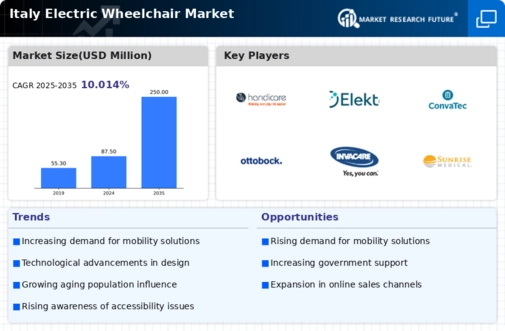Rising Healthcare Expenditure
Italy's rising healthcare expenditure plays a significant role in driving the electric wheelchair market. The Italian government has been increasing its investment in healthcare services, which includes funding for assistive devices like electric wheelchairs. In 2025, healthcare spending is projected to reach approximately €200 billion, reflecting a commitment to improving the quality of life for individuals with mobility impairments. This financial support enables more individuals to access electric wheelchairs, as they are often covered by health insurance or government subsidies. The electric wheelchair market stands to gain from this trend, as increased funding allows for greater innovation and accessibility in mobility solutions. Additionally, the focus on rehabilitation and long-term care further emphasizes the importance of electric wheelchairs in the healthcare system.
Increased Awareness of Disability Rights
The increased awareness of disability rights in Italy is a significant driver for the electric wheelchair market. Advocacy groups and non-profit organizations are actively promoting the rights of individuals with disabilities, leading to greater public consciousness regarding accessibility and mobility solutions. This heightened awareness encourages policymakers to implement regulations that support the inclusion of people with disabilities in society. As a result, there is a growing emphasis on providing access to electric wheelchairs as a means of enhancing mobility and independence. The electric wheelchair market is likely to benefit from this trend, as more individuals seek out electric wheelchairs to improve their quality of life. Furthermore, the push for inclusive public spaces and transportation options reinforces the demand for electric wheelchairs, making this a vital driver in the market.
Technological Innovations in Mobility Devices
Technological innovations are transforming the electric wheelchair market in Italy. Advances in battery technology, lightweight materials, and smart features are enhancing the functionality and appeal of electric wheelchairs. For instance, the integration of IoT technology allows users to monitor their wheelchair's performance and battery life through mobile applications. This trend is likely to attract a younger demographic, who may seek more advanced mobility solutions. The electric wheelchair market is experiencing a shift towards more sophisticated designs that prioritize user experience and comfort. As manufacturers invest in research and development, the introduction of new features, such as automated navigation and customizable settings, is expected to drive sales. This technological evolution not only improves the usability of electric wheelchairs but also positions them as essential tools for independence and mobility.
Aging Population and Demand for Mobility Solutions
The aging population in Italy is a crucial driver for the electric wheelchair market. As the demographic shifts, the number of individuals aged 65 and older is projected to increase significantly, leading to a heightened demand for mobility solutions. In 2025, approximately 23% of the Italian population is expected to be over 65 years old. This demographic trend indicates a growing need for electric wheelchairs, as older adults often face mobility challenges. The electric wheelchair market is likely to benefit from this trend, as families and caregivers seek reliable and efficient mobility aids to enhance the quality of life for elderly individuals. Furthermore, the increasing prevalence of age-related health issues, such as arthritis and reduced mobility, further propels the demand for electric wheelchairs, making this a pivotal driver in the market.
Rising Demand for Customization and Personalization
The rising demand for customization and personalization in mobility devices is shaping the electric wheelchair market. Consumers are increasingly seeking electric wheelchairs that cater to their specific needs and preferences, whether in terms of design, functionality, or features. This trend is particularly evident among younger users who desire mobility solutions that reflect their personal style and lifestyle. The electric wheelchair market is responding to this demand by offering a range of customizable options, from color choices to advanced technological features. This shift towards personalization not only enhances user satisfaction but also encourages manufacturers to innovate and differentiate their products. As the market evolves, the ability to tailor electric wheelchairs to individual preferences is likely to become a key competitive advantage, driving growth in the industry.
























Leave a Comment